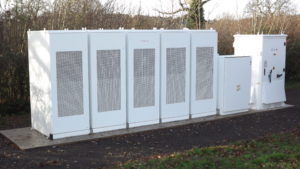
Open Energi and Camborne Energy Storage (CES) will take a half megawatt Tesla battery into National Grid’s Firm Frequency Response (FFR) market in the next few weeks.
The battery is colocated with a solar PV plant in Somerset and is also earning revenues from arbitrage, that is, charging for free via the solar panels, or from the grid when prices are low, and selling back to the market when prices peak.
Open Energi, which provides the demand response software via its Dynamic Demand platform, said the battery should be involved in the FFR market by the end of March.
While battery costs remain high, and there are challenges around connections to the grid, the technology is believed by many to be on the cusp of a boom akin to that experienced by solar PV five years ago.
Centrica believes that surge could begin as early as this summer. Meanwhile, UK Power Networks said in January that it received more than 12 gigawatts of connections applications from battery developers in little over a year (although it pointed out that some were “highly speculative”).
Camborne said it has consent in place for 50MW of battery storage, much of which will be colocated with solar PV.
Using batteries to manage intermittency of renewable generation is seen as a key element of decarbonising the UK power system. National Grid, for example, sees potential for up to 18GW of electricity storage by 2040.
Batteries also allow owner-operators to make more money from their generation because they are dispatchable, that is, provide power when required, and respond more quickly than many forms of generation.
Because revenues from fast response services are high, many investors are looking at setting up battery farms, i.e. approaching land owners with grid access to build battery sheds. But Open Energi said that is not necessarily the optimal outcome for bill payers.
“Energy storage is helping the UK transition to a smarter, cleaner energy system, but there’s more to unlocking value from it than putting a battery in a field,” said David Hill, the firm’s strategy director. “We’re using the latest machine learning techniques to manage battery performance in real-time. By understanding and managing state of charge in relation to fluctuations in solar PV generation and changes in electricity supply and demand we can maximise revenues and minimise wear and tear.”
Dan Taylor, MD at CES commented: “We have ambitious deployment targets for energy storage in the UK and this successful project is an exciting step forward for us and the industry. It demonstrates the vital role of energy storage in delivering secure, low carbon power to the UK. We are aiming to co-locate further energy storage with renewable generation throughout the UK and help make our electricity system fit for the future.”
Related articles:
Scottish Power asks Ofgem to change classification of batteries in capacity market
Capacity market too low for large gas, but gigawatts of DSR, batteries and CHP win contracts
Battery storage: Positive outlook?
National Grid says UK will miss 2020 targets, predicts big battery future
More than half of I&C firms mulling energy storage investment
Ofgem: Energy flexibility will become more valuable than energy efficiency
Smart grids ‘require local control and businesses must play or pay’
Nissan turns on 4.75MW solar plant, eyes battery storage market
Nissan and Eaton start rolling out commercial scale battery storage
Tesla: People don’t engage with energy bills, but they will have to
Ofgem: Energy flexibility will become more valuable than energy efficiency
Infrastructure chief: UK could be energy storage world leader if government acts now
National Grid boss: future of energy is demand not supply
National Grid says impact of solar requires greater system flexibility
Eon opens 2MW battery storage facility
Follow us at @EnergystMedia. For regular bulletins, sign up for the free newsletter.



